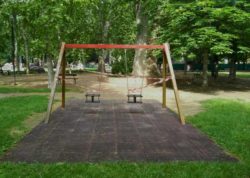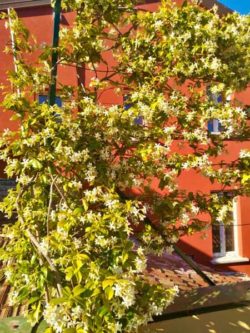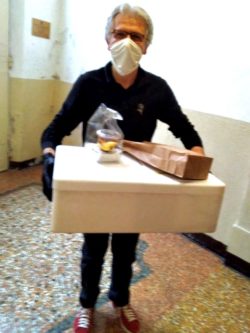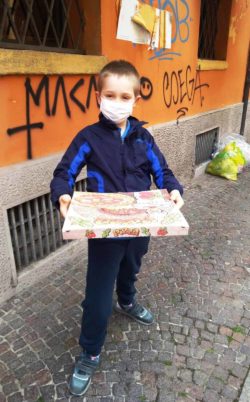Read Time: 6 Minutes Subscribe & Share
Get Ready To Lighten Up – An Update on Italy Reopening
 One of the many movies we watched during lockdown was The Forgotten Front, a documentary about the resistance movement in Bologna. The film’s website shows pictures of people gradually pouring into an empty Piazza Maggiore on April 25,1945, the date that is considered the end of Nazi and fascist occupation in Italy. Seeing people come together to reclaim their city after the war and twenty-three years of a fascist dictatorship is incredibly moving. This year though, those black and white scenes seemed all the more poignant as we still cannot flock to our beautiful city square to celebrate.
One of the many movies we watched during lockdown was The Forgotten Front, a documentary about the resistance movement in Bologna. The film’s website shows pictures of people gradually pouring into an empty Piazza Maggiore on April 25,1945, the date that is considered the end of Nazi and fascist occupation in Italy. Seeing people come together to reclaim their city after the war and twenty-three years of a fascist dictatorship is incredibly moving. This year though, those black and white scenes seemed all the more poignant as we still cannot flock to our beautiful city square to celebrate.
It’s inevitable that this experience shapes our language and thinking. Newspapers, politicians and public figures have frequently likened the coronavirus pandemic to a war. Two and a half months of a worldwide shutdown can’t be compared to the likes of World War II. Still, who will ever forget watching army trucks transporting coffins from Bergamo to other regions in Italy as local crematoriums could no longer cope with the numbers.
In a way, we all felt like we were in the resistance movement against the spike-pronged sphere. Whenever I asked friends about how they were faring, they would message back: resistiamo. We resist.
April Is The Cruelest Month
 The opening line of T.S. Eliot’s The Wasteland describes what so many experienced during the month that is normally a joyful ode to spring. Bologna in April had a soundscape of church bells and ambulances. When the archbishop here ordered all bells to be rung at midday in remembrance of the dead on March 27, the daily clanging became a reminder over the coming weeks of the invisible tidal wave that continued to claim lives, even as it began to slow down. April 25, Liberation Day, is normally a noisy festive occasion with crowded streets, brass bands, music performances, solemn and soulful tributes and Bella Ciao being sung by spontaneous groups throughout the day. This year people sang the partisan anthem from inside their homes while Paolo Fresu played the tune on his trumpet alone in an empty Piazza Maggiore.
The opening line of T.S. Eliot’s The Wasteland describes what so many experienced during the month that is normally a joyful ode to spring. Bologna in April had a soundscape of church bells and ambulances. When the archbishop here ordered all bells to be rung at midday in remembrance of the dead on March 27, the daily clanging became a reminder over the coming weeks of the invisible tidal wave that continued to claim lives, even as it began to slow down. April 25, Liberation Day, is normally a noisy festive occasion with crowded streets, brass bands, music performances, solemn and soulful tributes and Bella Ciao being sung by spontaneous groups throughout the day. This year people sang the partisan anthem from inside their homes while Paolo Fresu played the tune on his trumpet alone in an empty Piazza Maggiore.
We stayed at home and abided by some of the toughest restrictive measures put into place by a Western country. All but essential businesses and industries shut down. In addition to stay-at-home orders and social distancing, parks were closed and if you wanted to exercise outside you had to do it within 200 meters of your home, if at all. Our work, our children’s education and our social lives were, for the most part, moved to the screens of computers and phones, or came to a halt altogether.
One of the hardest pills to swallow for families was schools and nurseries closing and realizing they would not reopen for the academic year. How can people work without forms of organized childcare? How can children grow, learn and blossom without being around their peers and professionals specialized in education? If you had any doubt about the importance of teachers – whether capable or not – you probably have re-considered your opinion. As online schooling was slow to start here, we played our part as educators with both disastrous and brilliant results.

Lucy Jones in The Guardian suggested observing nature wherever possible as a powerful means of coping with quarantine anxiety. Though we couldn’t go for a ramble in the hills, run to the park or enjoy the company of friends, we could still gaze at the stars, smell the jasmine bloom and marvel at the transformation of pink flowers into strawberries on our deck. We felt blessed to have an outdoor space as part of our home for playing hopscotch and learning how to jump rope. Whoever had a courtyard, balcony, porch or garden surely put it to use like they never have before.
Cheer also came in the form of cooking and seeing local businesses reinvent themselves with home delivery and online services. We made ciambellone three times a week and pizza so delicious we wondered why we ever order it. Supermarkets here were overloaded pretty quickly with home delivery orders, so we turned to our favorite food shops and discovered that they were mostly up and running with consegna a domicilio: our Easter leg of lamb came from the Polleria Ranocchi 1972, cheese and salumi from La Baita Vecchia Malga, and fruit and vegetables from a farmer-run store. Luxury of luxuries was receiving a lunch from La Rosa with a summer truffle lasagna that was so heavenly it reminded me of the magic of Italian cuisine. We watched historic soccer matches and imparted cocktail making to our eight-year-old son.
Maggio, Adagio Adagio
There is a saying in Italian about gradually lightening cold weather clothes in the transition from spring to summer: aprile, non ti scoprire; maggio, adagio adagio; giugno, apri il pugno. The easing of lockdown (or Italy Reopening) seems to be following the same pattern. It officially began on May 4 with most businesses reopening and an easing of restrictions on personal movement. Parks opened again. People could now move within the same region for reasons other than work, and we could finally start walking or running beyond 200 meters from our homes. The soundscape changed too, with construction sites buzzing and blasting.
 Our first ventures were to Piazza Maggiore and then to Parco Montagnola where children with masks on ran or rode bikes, and our son saw friends in person for the first time in two and a half months. It was hard to stop them from hugging. Parents approached each other maintaining that invisible meter between them, fumbling with masks while trying to converse. We felt a cautious euphoria, like wanting to jump for joy but not sure if you can.
Our first ventures were to Piazza Maggiore and then to Parco Montagnola where children with masks on ran or rode bikes, and our son saw friends in person for the first time in two and a half months. It was hard to stop them from hugging. Parents approached each other maintaining that invisible meter between them, fumbling with masks while trying to converse. We felt a cautious euphoria, like wanting to jump for joy but not sure if you can.
Going out tempts us to shed how rigorously we upheld the rules of sheltering in place, punctually cleaning and disinfecting our hands and homes, and how wary we were of leaving the confines of our safe domestic space. The first week I religiously went out with a mask and plastic gloves. Two weeks later my mask hangs around my neck and the rest of the Covid kit is stashed in my bag and pulled out as needed.
The timeline of reopening stretches from May to July 31 as the planned end of the emergency state. As I write this on May 18, stores, hairdressers, bars and restaurants unlocked their doors again, albeit following strict social distancing and hygienic guidelines. Museums, libraries, churches and monuments too. On May 25 the green light will be given to gyms, recreation centers and beach resorts. June 3 borders will open again permitting travel.
The question on everyone’s mind here is, now that we’re over the peak, business and institutions can reopen and we can return to work, what exactly will our post-pandemic world look like? Are the beach umbrellas surrounded by plexiglass walls imagined by Rimini beach resort owners too creepily futuristic or the way things need to be? One thing is clear, we must prepare ourselves for a second spike, dealing with unemployment and businesses going bankrupt, and, not the least, personal psychological breakdown.
We all know that if the R0 goes up again, lockdown will return like it has in China. The prime minister, regional governors and mayors all remind us of our personal responsibility and behavior for mitigating the risks of living with Covid-19. With no tangible vaccine in sight, we are all called into action.
Even so, the feeling of freedom is sweet.

Juggling nuance between Italian and English, Tatiana lights up her five-burner kitchen top with nostalgia for American food, Bologna-inspired fare and cross-cultural inventions. She and her husband endlessly debate on cooking with or without a recipe. Their son just hopes that dinner will either be plain or have chocolate in it.




I just finished reading “We Were the Lucky Ones” by Georgia Hunter last night, so hard to put down. The book includes the multinational effort to retake Monte Cassino. Thanks for sharing the photos and recommendation of The Forgotten Front. The war impacted so many more people and places than we remember.